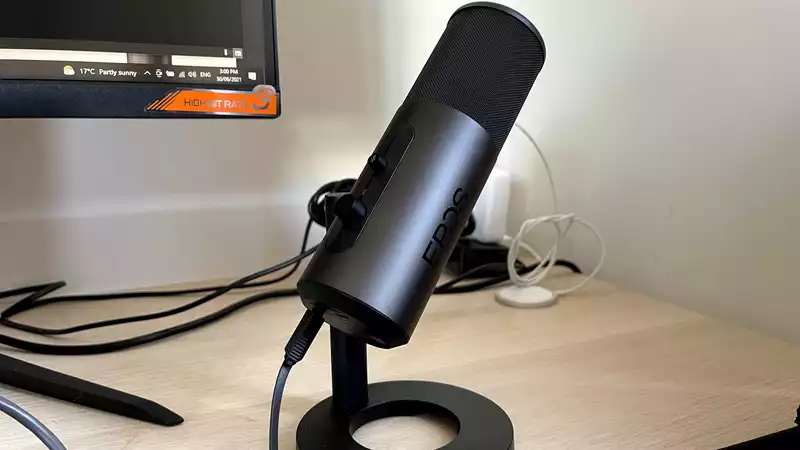EPOS B20 streaming microphones are trying to make their presence felt right from the start. Look at us, we are all grown up and serious. From its sleek and elegant black packaging, the $199 (£179) B20 immediately separates itself from the rest in the looks department. It follows the gunmetal color scheme seen on the excellent GTW 270 wireless earphones and the EPOS H3 wired gaming headset. The family resemblance is obvious and a clear indication that EPOS is trying to move away from the old Sennheiser gaming look. The company is growing and I like it.
The EPOS B20 is a USB desk mic aimed at streamers and podcasters, but is it good enough to be in our best microphones guide? It aims to provide 24-bit broadcast quality with plug-and-play USB connectivity, sidetone built into the mic, and four pickup patterns for different use cases. A desk stand is included in the box, but if you want to use the boom arm, you can thanks to a 3/8-inch screw. The B20 also picks up vibrations through the stand, so if you are serious about audio, this is the way to go.
Returning to the B20's design, simplicity and elegance are the order of the day. It is a tall, dark metal cylinder with a mesh top third for pickups and volume and mute controls on the front; LED indicators glow white when the microphone is in use and red when muted. This LED indicator also helps you know which side the microphone is facing. On the back are two dials for changing the pickup pattern and noise gain. Below the microphone is a USB-C port and a 3.5 mm audio jack for monitoring the microphone audio through headphones.
Right out of the box, the microphone sounds great. It picks up my voice very clearly with no distortion, compression, or grating, which is a big improvement over any gaming headset microphone. You can adjust the gain, sidetone volume, and pickup pattern with the on-board dials, but if you want to get the most out of the mic, you will need to use the EPOS Gaming suite software.
This software allows you to control everything from gain to noise cancellation to sidetone. The Gaming suite software is the simplest and most visually pleasing software available. Everything is clearly displayed, and large EQ graphs make it easy to monitor changes in real time. You can also record short snippets to see how every change affects the final sound output.
Perhaps the B20's biggest party trick, however, is the multiple pickup patterns that can be selected via a dial on the back of the mic or in the gaming suite. There are four types to be exact: unidirectional, bi-directional, stereo, and omnidirectional. Most people would use the unidirectional pattern, which is best for a single person speaking directly into the microphone. However, if you are doing a podcast with guests, for example, use a bi-directional or omnidirectional pattern to pick up multiple voices around the microphone.
In most cases, the microphone sounds great but is sensitive to ambient noise. After hours of fiddling with the settings, I could not get rid of the subtle background hiss. Overall, this does not detract from the microphone's excellent sound reproduction, which I think most people will find satisfactory. However, if you are recording professional audio for video or voice-over, you will want to be sure to remove any ambient sound.
Now that headphones can be connected to the B20, the excellent EQ and virtual surround sound of the EPOS can be used. I noticed a marked improvement in warmth and bass when driving the headphones through the microphone. However, the B20 must be set as the default audio device in Windows. Of course, microphone monitoring is also available and one can hear one's own voice through the microphone.
The monitoring capability is built into the microphone, which is great because you can connect it to a MacBook or PlayStation that doesn't have EPOS software and not lose any core functionality.
At $199, the B20 is not a cheap mic, and its price is on par with the big boys like the Blue Yeti X, Razer Seiren X, and our favorite mic, the Shure MV7 Podcast. Still, for the company's first desk mic, we're very happy with this first iteration: the B20 looks and sounds great, and the EPOS gaming suite gives us the control we need: Zoom calls, Twitch streams, Garage podcasts, and more, Whatever the application, the B20 is stylish and graceful and will match any desk setup; if EPOS can solve the background hiss noise, the B20 will be a winner.
.

Comments